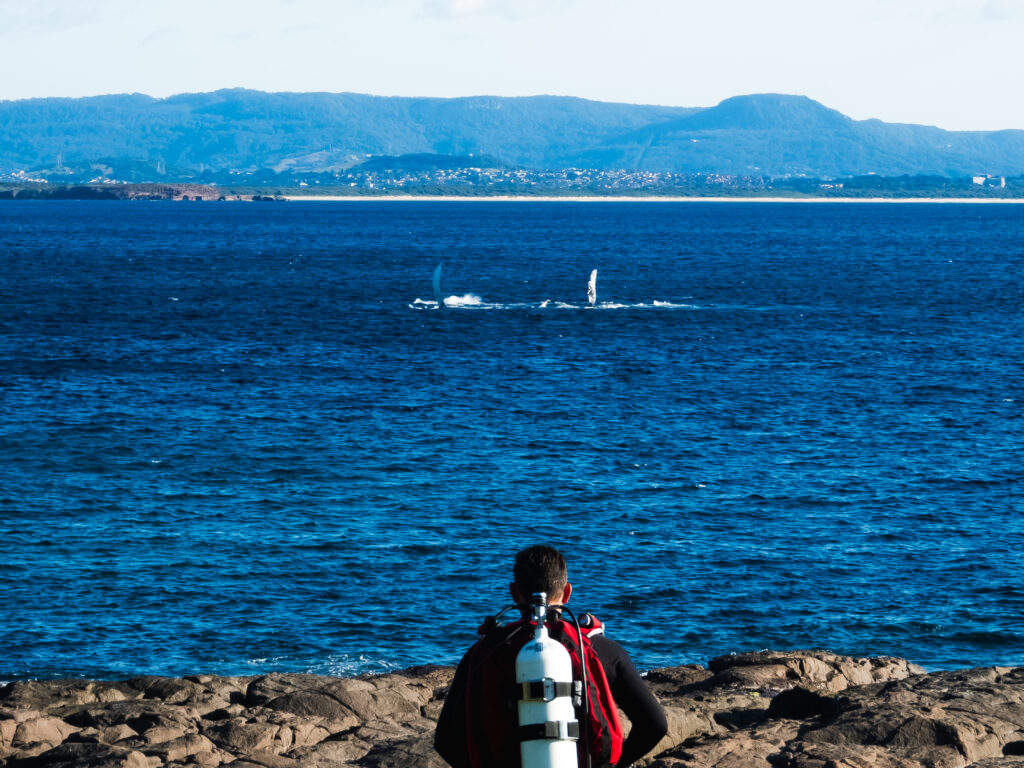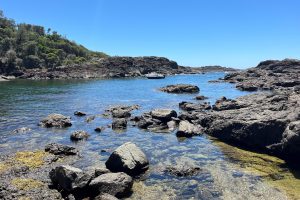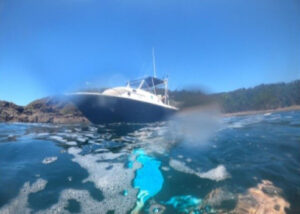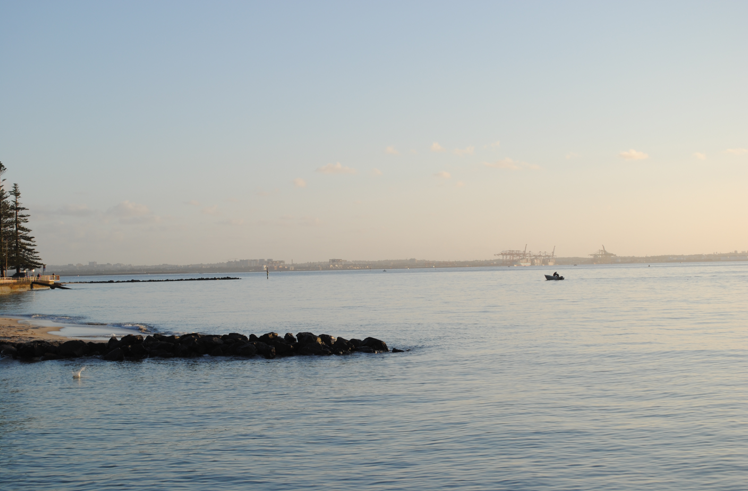
What do NSW scuba divers, Josephite Sisters and a Catholic priest have in common? A commitment to care for the environment… Robert Purdon is a health worker, lover of nature and volunteer. He writes on behalf of the Josephite Laudato Si’ Action Plan Team.
Bushrangers Bay is an aquatic reserve in Shellharbour, New South Wales (NSW). The legislation around Bushrangers Bay and Bass Point is not black and white, and certain political groups have lobbied government for a weakening of the legislation and regulation that provides protection to marine life.
The area is often encroached upon by fisherman, where many Grey Nurse sharks can often be seen and, even though the Grey Nurse look dangerous, they are harmless to humans. Grey Nurse sharks are a protected species and critically endangered due to overfishing in the past.
People who scuba dive in Bushrangers Bay and other dive locations in Bass Point often witness marine life such as the Grey Nurse with gang hooks in their mouth, turtles with fishing line wrapped around their fore flippers and even a whale with a fishing net wrapped around its tail fin. There are studies that show how gang hooks can damage the mouth of the Grey Nurse shark, lead to infection and prevent the sharks from feeding properly, resulting in poor health or death.

In December 2024 a local scuba diver posted on a group chat “A boat has anchored in Bushrangers Bay.”
Everyone on the group chat were frantically looking up who they could call and were trying to clarify the rules about boats anchoring in Bushrangers Bay.
“Can you get the rego number of the boat?”
“I can’t see it”
“Marine sanctuary regulation 1995 section 35 no anchors”

At the time the scuba diver was not planning on going for a swim, but he run up to his car, got his flippers and swam out to the boat to get evidence.
“Swam out and got its rego number, definitely had fishing rods on it”
“Send the photos to the maritime or police.”
“Maritime”
Most of these local scuba divers were at work at the time and the commitment shown by everyone demonstrate how much they love and care for this place and its protection.
Later that day one of the scuba divers posted on the group chat:
This story is a long chain of stories of individuals and community groups doing their best in NSW to protect and care for the environment.
Over 140 years ago Catholic priest Fr Julian Tenison Woods, wrote about the Grey Nurse shark. Fr Julian was a geologist, explorer, and lover of nature and in partnership with Australia’s first canonised Saint, Mary MacKillop, co-founded the Sisters of Saint Joseph of the Sacred Heart. In 1882 Fr Julian wrote in Fish and Fisheries of New South Wales as follows:
The Grey-Nurse
The ‘nurse’ here referred to is Odontaspis Americanus… it attains the length of 15 feet with a much larger girth in proportion to other sharks; but the females which have been caught were not so long – 8 to 12 feet – with an exception or two where they have been longer. There are incidents of interest connected with its season and capture worthy of note.
This shark in appearance is comparatively short. That, however, is accounted for by its great girth, for I have known the length of a nurse to be 12 and its girth 7 feet. They have a longer and more pointed nose than the sea-shark, and the eye and nostril are in a straight line. The mouth, which is situated directly under the eye, is of a crescent shape, and the jaws are armed with four or five rows of teeth, formidable and sharp.
These sharks are caught in October, November, and part of December, for their oil alone. After the latter month the liver yields little or none. During these months they yield a considerable quantity, the quality of which is good, and excellent for burning in lamps.
These sharks used to be caught in Botany Bay, at regular ‘nursery’ grounds, near to the Seven-mile Beach, and what is known as Dolls Point; where they could be seen of a calm day during the months of October and November, lying on the bottom in regular rows like logs of timber, and each row apparently as if they had been selected of one size. During these months, and on these grounds, they were caught with line and hook. Singular to remark that this operation was at one time systematically carried on, and the oil obtained was used by the whaling ships at the Tower of Government station situate at the south-head, and at the mole of Botany Bay for years.
At present, little fishing for the liver takes place. This was the amount extracted from these sharks up till 1857, when a new expense came into force, and has gone on till now, amounting to one hundred and one out of twenty-eight caught in 1857, at one fishing, there were 24 gallons of oil extracted each. Occasionally a very large one is caught, and this forms the exception.
In fishing for the grey-nurse, when any one of them takes the bait, the others rush to his assistance, whether to participate in the food or other causes not clear is not known. The noise and struggles of the one taken on the line will invite the rest to come to his rescue, and very often another one or two will move up the same hook. To seize the shark when he approaches the boat, is done by a gaff hook, fixed on a long pole; or, in case he is slow to come to hand the chain-line, he is brought on the deck and cut open with a spade, the oil extracted. These sharks are very vicious and move about freely; and when one is fishing for others and happens to hook a shark of this kind, he will rise to great strength, grasp the boat about, kellick and all, apparently without much exertion.
The ‘nurse’ has been known to seize hold of the steer oar of a whale-boat when the boat has been moving rapidly through the water, and shake it with its teeth two or three times, let go its hold, and pursue and seize it again as if it was a living object, or, as it were, in derision or sport. At other times it has been known to attack the boat as if it smelled the bait within, or hover about, putting in an appearance every now and then. It was supposed that sharks could smell the living freight on board the ships connected with the slave ships in days of old; so with these, they have been known to seize hold of the stern-post and shake the boat till it quivered again.
Heterodontus or Cestracion has a peculiar interest attached to it, on account of its being of a form which prevailed in past geological times or at least dates very like it. The fossil forms exceed in size the species of our coast. They make their appearance in the Devonian period, increasing in the Carboniferous, and surviving up to the Chalk. The majority of the species however lived in the earlier secondary period.
The spot referred to by Fr Julian as Seven Mile Beach in Fish and Fisheries of New South Wales is now named Dolls Point Beach, Dolls Point, Sydney NSW. The photograph below was taken in January 2025 and in it you can see the rock groins which were installed to prevent beach erosion following the construction of Port Botany and other developments in Botany Bay. There are currently signs there warning swimmers of strong currents and sharks in the area. It is well known that there are dangerous currents resulting from the changes in the hydrology of the bay due to developments. However, it is unlikely that any Grey Nurse sharks remain in the area.
 Photograph of the place referred to as Seven Mile Beach by Fr Tenison Woods. Image credit: Robert Purdon.
Photograph of the place referred to as Seven Mile Beach by Fr Tenison Woods. Image credit: Robert Purdon.
Underwater photographer, marine biologist and editor of Dive Log Australasia, Mike Scotland, has been scuba diving in Botany Bay for the past 45 years. Mike says specific areas in Botany Bay offers some of the most beautiful dive sites in Sydney however these eco systems are not how they should be. He says that overfishing, the construction of Port Botany and the Sydney Desalination Plant at Kurnell, has led to fish stock and other marine life being severely depleted over the years. Mike says local fishers used to say that the marine life was in such abundance 70 years ago that commercial fisherman would catch a ton of fish using nets from Silver Beach, Kurnell. When asked about the presence of the Grey Nurse shark in Botany Bay, Mike said Grey Nurses are occasionally seen but nowhere near the numbers seen in the 1800s.
In 1882, Fr Julian wrote that when one of the Grey Nurse sharks “takes the bait, the others rush towards it with the view either to participate in the food or to protect the one which has taken the hook, for they then overlie each other to that extent that it is like being fast to a rock; a constant and heavy strain alone will move the one you are fast to”. In 2024, while diving at Bush Rangers Bay, Shell Harbour a local scuba diver witnessed a similar helping behaviour from a Grey Nurse shark. He wrote that a Grey Nurse shark with a gang hook in its mouth kept coming up to the divers in what seemed like an attempt for help.

“I think this guy has been in the wars.
Is it the guys out of UNSW who do the catch, de-hook and release?
He kept coming up to us.”
Pope Francis explains in Laudato Si’ On Care For Our Common Home that our treatment of the environment is linked to our social systems and behaviours towards one another.
Pope Francis is quoted as saying;
In 2018, the Australian Broadcasting Commission reported that the NSW State Government overturned a decision to create a series of marine sanctuaries along the NSW coast due to campaigning from the Shooters and Fishers Party. Bushrangers Bay, Shellharbour and Towra Point in Botany Bay were both part of this plan. The reasoning given by the Primary Industries Minister regarding overturning the decision was that “we don’t want to reduce the fishing access of the fishing rights when we have this marine park” It was highlighted at the Save our Sanctuaries Public Forum in 2024 that the creation of marine sanctuaries along the NSW coast would not only provide high level protection for critically endangered species, like the Grey Nurse shark, but would also result in a spillover of fish stock into other areas not classified as no fish zones. They say that the establishment of Marine Sanctuaries in these areas would improve fishing opportunities for anglers.
Pope Francis also says that while governments are not always willing to protect the environment “local individuals and groups can make a real difference.”
The local scuba divers at Shellharbour are one of these groups Pope Francis refers to, doing their best in the face of powerful opposition to protect what they see as a beautiful marine eco system gifted to current and future generation and their local community.
For more information about the work of the Josephite Laudato Si’ Action Plan Team visit the Sisters of Saint Joseph website.
Robert Purdon
View photos of Grey Nurse sharks in the gallery below.
